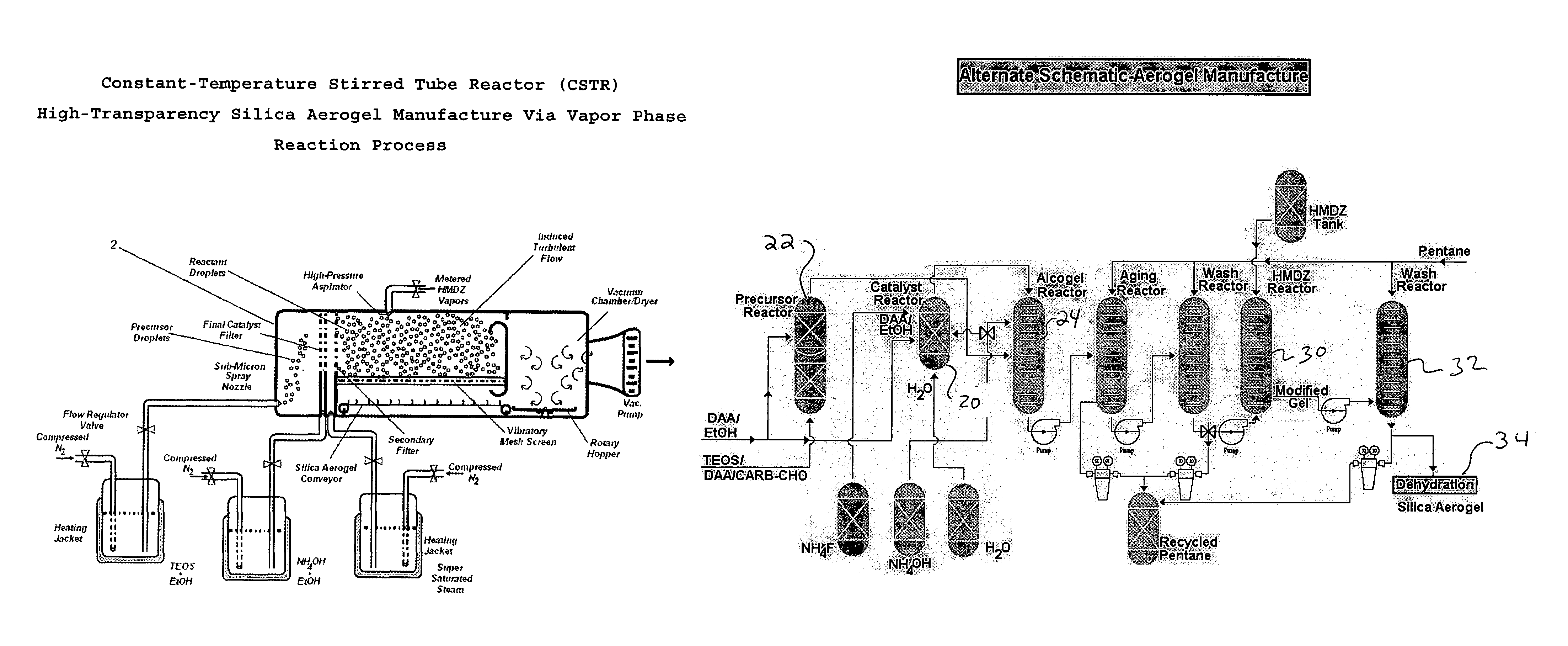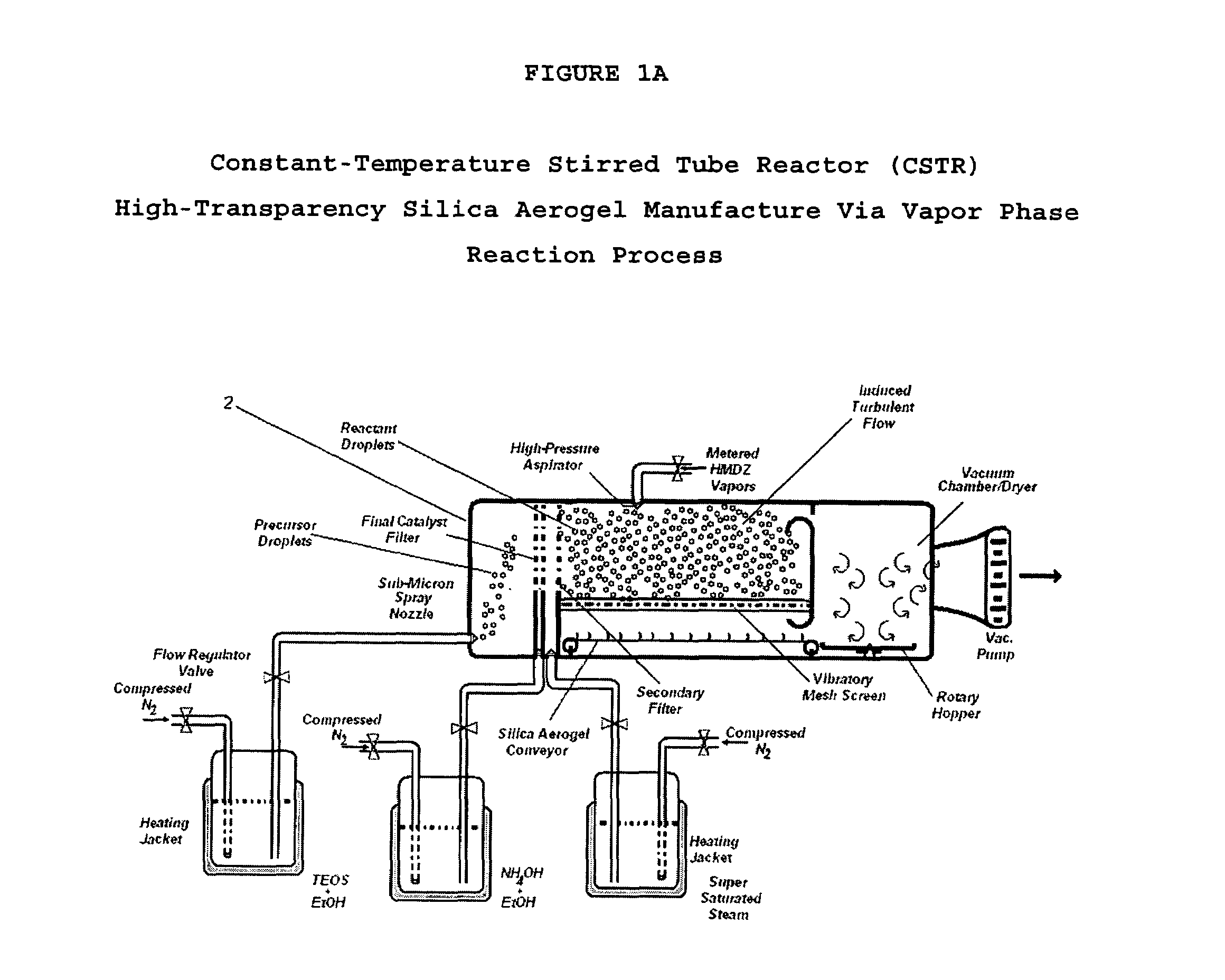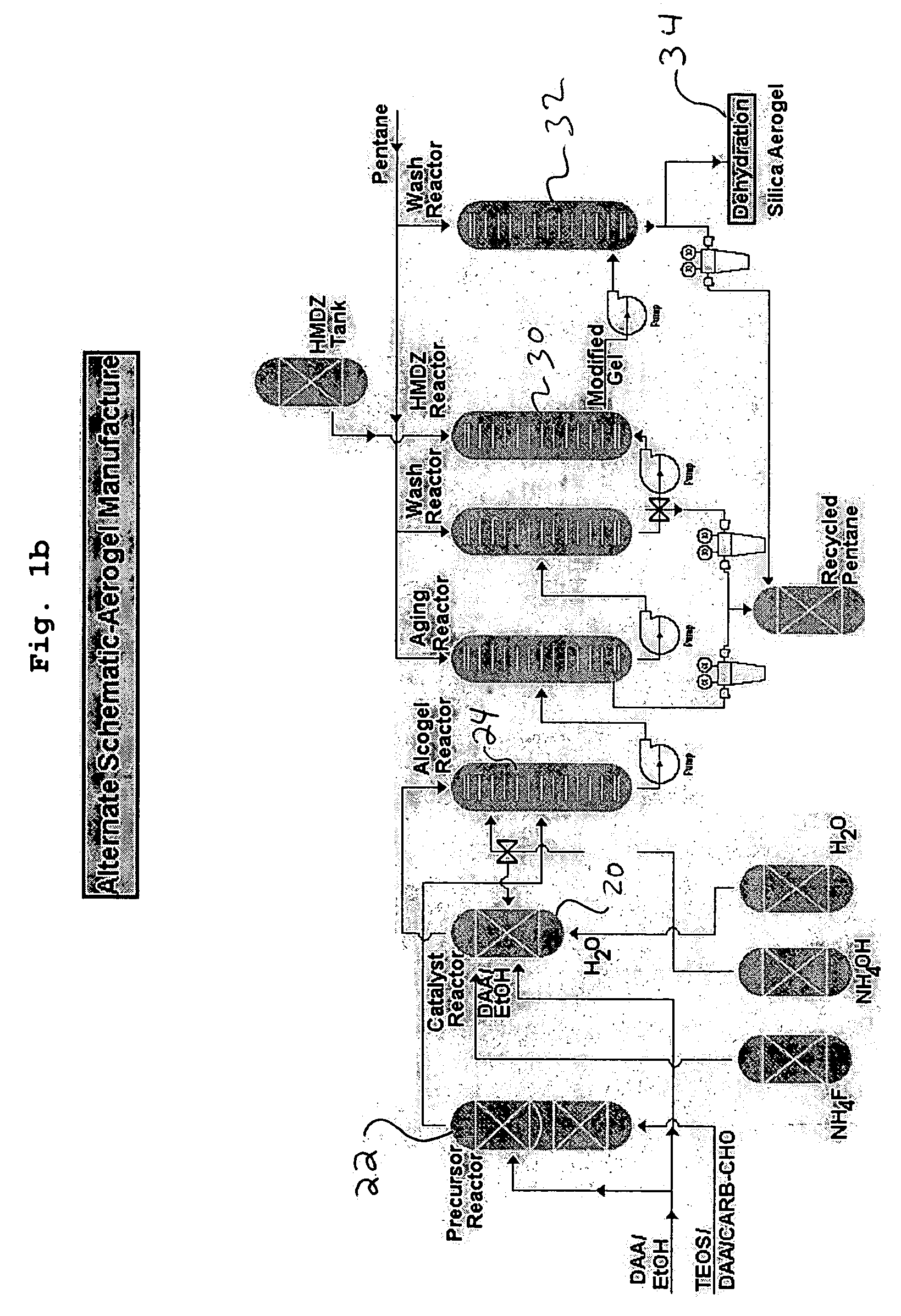Aerogel and method of manufacturing same
- Summary
- Abstract
- Description
- Claims
- Application Information
AI Technical Summary
Benefits of technology
Problems solved by technology
Method used
Image
Examples
example 1
A. Preparation of Precursor Solution
[0087]Wt. of chilled (i.e., 20° F. to 43° F. (−6.7°-6.1° C.)) alkoxide=440.4 grams
[0088]Wt. of chilled (i.e., 20° F. to 43° F. (−6.7°-6.1° C.)) absolute EtOH=400 grams
B. Preparation of Catalyst Solution
[0089]Wt. of chilled (i.e., 20° F. to 43° F. (−6.7°-6.1° C.)) absolute EtOH=240 grams
[0090]Wt. of chilled (i.e., 34° F. to 43° F. (1.1°-6.1° C.)) de-ionized water=333 grams
[0091]Wt. of ammonium hydroxide (i.e., 20° F. to 43° F. (−6.7°-6.1° C.))=1.79 grams (for a final pH of 12.20 or gamma-APTES=(1.20 grams) with the catalyst solution having a temperature of between 34° F. to 43° F. (1.1°-6.1° C.) so as to prevent crystallization or freezing of the water within the solution. The final aerogel properties are C=0.0045 μm4 / cm; Light Scattering Coefficient A=0.884; Light Transmission (% LT) of 41% for Artificial Light and 25-27% for Blue Sky, and for a Kalwall Panel incorporating the inventive aerogel, a Light Transmission (% LT) of 25-27% for Artificial...
example 2
A. Preparation of Precursor Solution
[0093]Wt. of chilled (i.e., 20° F. to 43° F. (−6.7°-6.1° C.)) alkoxide=900 grams
[0094]Wt. of chilled (i.e., 20° F. to 43° F. (−6.7°-6.1° C.)) absolute EtOH=800 grams
B. Preparation of Catalyst Solution
[0095]Wt. of chilled (i.e., 20° F. to 43° F. (−6.7°-6.1° C.)) absolute EtOH=560 grams
[0096]Wt. of chilled (i.e., 20° F. to 43° F. (−6.7°-6.1° C.)) ammonium hydroxide=2.27 grams (for a final pH=12.20 or gamma-APTES=1.83 grams) with the catalyst solution having a temperature of between (i.e., 20° F. to 43° F. (−6.7°-6.1° C.). The final aerogel properties are C=0.0065 μm4 / cm; Light Scattering Coefficient A=0.780; Light transmission (% LT) of 41% for Artificial Light, 25-27% for Blue Sky, 25-27% for Artificial Light passing through a Kalwall Panel incorporating the inventive aerogel, and 19-20% for Blue Sky Day passing through a Kalwall Panel incorporating the inventive aerogel; Density of 0.044-0.091 g / cc; a Bulk Modulus of Elasticity=0.33 Gpa; and a Dur...
example 3
A. Preparation of Precursor Solution
[0098]Wt. of chilled (i.e., 20° F. to 43° F. (−6.7°-6.1° C.)) alkoxide=225.0 grams
[0099]Wt. of chilled (i.e., 20° F. to 43° F. (−6.7°-6.1° C.)) DAA=200.0 grams
B. Preparation of Catalyst Solution
[0100]Wt. of chilled (i.e., 20° F. to 43° F. (−6.7°-6.1° C.)) DAA=240 grams
[0101]Wt. of chilled 34° F. to 43° F. (1.1°-6.1° C.) de-ionized water=333 grams
[0102]Wt. of chilled (i.e., 20° F. to 43° F. (−6.7°-6.1° C.)) ammonium hydroxide=2.45 grams (for a final pH=12.20 or gamma-APTES=2.11 grams) with the catalyst solution having a temperature of between 34° F. to 43° F. (1.1°-6.1° C.) so as to prevent crystallization or freezing of the water within the solution. The final aerogel properties are C=0.0031 μm4 / cm; Light Scattering Coefficient A=0.872; Light transmission (% LT) of 41% for Artificial Light, 25-27% for Blue Sky, 25-27% for Artificial Light passing through a Kalwall Panel incorporating the inventive aerogel, and 19-20% for Blue Sky Day passing throu...
PUM
 Login to View More
Login to View More Abstract
Description
Claims
Application Information
 Login to View More
Login to View More - R&D
- Intellectual Property
- Life Sciences
- Materials
- Tech Scout
- Unparalleled Data Quality
- Higher Quality Content
- 60% Fewer Hallucinations
Browse by: Latest US Patents, China's latest patents, Technical Efficacy Thesaurus, Application Domain, Technology Topic, Popular Technical Reports.
© 2025 PatSnap. All rights reserved.Legal|Privacy policy|Modern Slavery Act Transparency Statement|Sitemap|About US| Contact US: help@patsnap.com



